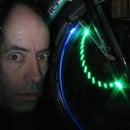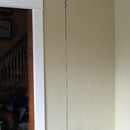Introduction: Glowing Light From Packaging Waste
So you've enjoyed a great bottle of champagne, but now the bottle is in the recycling bin, your cat is playing with the cork, and you are wondering what to do with the neat box it came in?
Boy, have I got a great project for you!
We will take a beautiful plastic box, which is otherwise destined for the landfill, and turn it into a powerful room accent.
While the component dimensions are developed for the particular box which I used, the project is simple enough to be easily adaptable to other sizes of boxes.
If you have a box that is coloured and has some graphic decoration, then it is a good candidate for this project.
Go for it!
Step 1: Yay! a Short Materials List!
In addition to your plastic box, you will need these items:
1. Low-wattage lighting components: I recommend a "PL" type of compact fluorescent bulb. This example uses a PL-18 (18 watts). Lower wattage systems are available; they use shorter bulbs which would be appropriate for shorter boxes.
Source: a specialized electrical supply store ought to be able to outfit you with bulbs, socket, and ballast. DON'T leave the supply store without a ballast/socket/power wiring diagram!
2. Other electrical components are:
-two-wire cord
-two prong plug
-switch
-twist wire connectors
Source: most hardware stores.
3. A small piece of plywood, Masonite, MDF, at least 1/4 inch thick.
Sources: your scrap bin, your neighbour's scrap bin, the dumpster down the street...
4. Wood screws:
-#4 x 3/8 inch long
-#8 x 1 3/4 inch long
(Please don't obsess about these specifications, many other sizes will work but this is what I used)
Sources: your spare screw jar, the hardware store if you are not a pack rat
NOTE: The box I used is approximately 3.5 inches square and 12.75 inches tall; my light assembly is 10.75 inches tall using the PL-18 bulb.
The PL bulbs are available in a whole range of wattages and sizes.
For instance, using the PL-5 bulb would result in an assembly 7 to 8 inches tall, and the ballast is smaller. So this would suit shorter and narrower boxes.
Step 2: Prepare Your Base
This is where we fabricate the base, using the sheet material.
1. Cut the sheet material to give at least 3/16 inch clearance inside the box.
My box measures approximately 3.5 inch square, so the sheet is cut to 3.25 inch square.
2. Lay out the socket to center the bulb on the base, mark the flange mounting hole locations on the base, then pre-drill the base for the screw holes.
If you are using #4 screws, then pre-drill with 1/16th inch bit.
3. Trace the route for the wires, and cut a notch in the side of the sheet to suit the wires.
4. Lay out the ballast on the bottom side; you will probably have to shove it over to one side to make room for the wires. Be sure to consider the room required for the wire connectors. Again, transfer the flange mounting holes to the base, then pre-drill.
5. Install the socket and the ballast, then fold the wires into place.
6. Pre-drill the corners of the base for screws: #8 screws are pre-drilled with a 1/8th inch bit.
These screws serve as feet for the base, and ensure that the ballast does not come into contact with the plastic box.
Step 3: Prepare the Box
You need to cut a hole for the wire to pass through.
Presumably, you will have chosen a box panel that will be the light's front.
So cut the hole in a side or rear panel, about 1/2 inch from the bottom, and 1/2 inch from the edge of the box.
The hole should be the same size as the wire.
Use something like an Xacto knife.
Step 4: Wiring
A few precautions need to be followed during this sequence: a mistake here can cause injury or start a fire.
This is simple stuff, but there is no room for error. So always double-check your work, and get someone else to check the wiring if you are not comfortable.
The steps I identify as critical are the ones that MUST be completed correctly.
1. Connect the ballast to the socket. The ballast wires may already have the ends stripped; if not, strip off no more than 1/2 inch. Be sure to choose the correct wires; this step may be difficult to undo! Consult the ballast's wiring diagram. Push those wires into the socket's appropriate holes. -CRITICAL STEP
2. The two-prong plug should have one prong that is wider than the other, and this feature should fit only one way into the wall socket (i.e. you shouldn't be able to flip it). You will use the wire running from the narrow plug for the switch.** See note below for more info.
3. Pick a spot in the wire that you believe will be a convenient location, perhaps 18 inches from the end that will connect to the light. At that spot, cut the conductor running from the narrow prong and install the switch. -CRITICAL STEP
4. Run about 15 inches of wire through the box, from the outside.
5. You should have the conductors split for a length of about 3".
6. Tie a knot using one of the conductors. This will prevent the wire from being pulled out of the box, in the event of an accident. -CRITICAL STEP
7. The power wires should then be connected to the ballast. Be sure that you choose the correct wires. The wire ends should be stripped for 1/2 inch, and no longer. The twist connectors should be applied firmly; loose is dangerous. For extra safety, you can use electrical tape to fasten the connectors to the wires. -CRITICAL STEP
8. Double-check all of your connections.
Are the connections solid? They should not come apart when you tug on them.
Is the ballast correctly wired to the power wire and to the socket? Check against the ballast's wiring diagram. -CRITICAL STEP
9. LIVE TEST!
Install the bulb, plug it in and flip the switch.
10. Slip the assembly into the box, while pulling the slack power wire.
If you have any questions or concerns about the wiring, PLEASE ask your question.
**NOTE: The narrower prong will make contact with the hot conductor in the wall socket, while the wider prong will make contact with the neutral conductor in the wall socket.
In a properly wired wall socket (in North America at least) only the hot conductor will actually carry current. Therefore, putting the switch on this conductor can greatly limit the dangers of short circuits, and electrocution, in damaged electrical fixtures.
Step 5: Enjoy
Congratulations!
I hope you enjoyed your project, and especially that you enjoy the results.
Please let me know if anything is unclear with my instructions.













